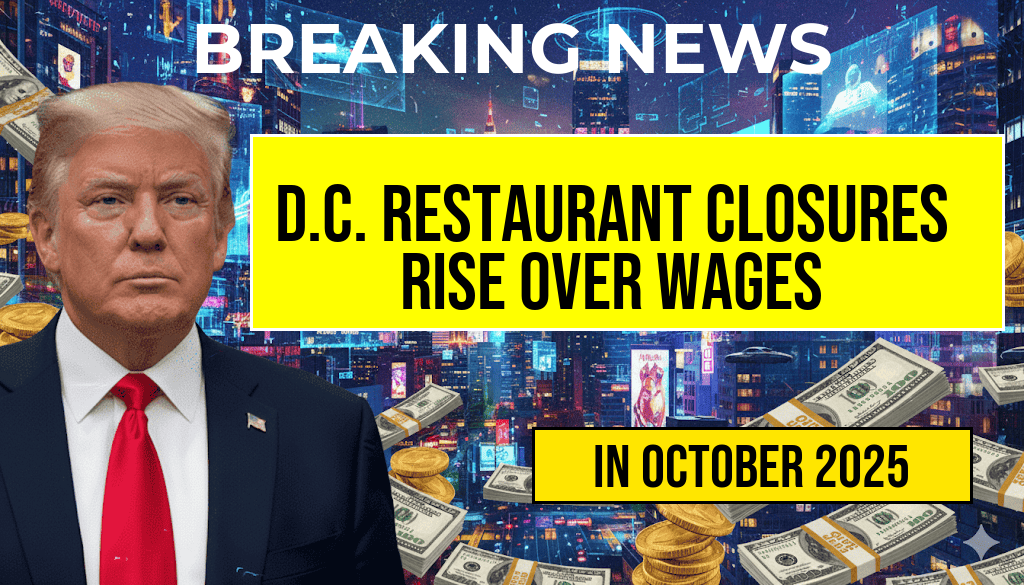DC Restaurants Hit with Surcharges Over $20 Per Check as Rising Wages Fuel Higher Costs
Patrons dining across Washington, D.C., are increasingly facing bills that include surcharges exceeding $20 per check, a direct result of escalating labor costs driven by recent wage regulations. Local eateries, from casual cafes to upscale establishments, are adjusting their pricing strategies amid a complex economic landscape where mandated wage hikes and staffing shortages converge. Industry insiders report that these surcharges, often labeled as “service fees” or “cost recovery charges,” are now commonplace, reflecting the financial pressures restaurants face in maintaining staffing levels while complying with new wage laws. As the city’s dining scene evolves, consumers and operators alike grapple with understanding these additional charges and their implications for affordability and sustainability.
Wage Regulations and Their Impact on Restaurant Operating Costs
The surge in surcharges correlates closely with recent changes to wage regulations enacted by the District of Columbia. In 2022, D.C. increased its minimum wage to $16.10 per hour, with plans to reach $17.50 by 2026. These increases, while aimed at boosting worker pay, have significantly raised labor expenses for restaurant owners already navigating inflation and supply chain disruptions.
“A typical restaurant with a staff of 20 employees is now facing an additional $5,000 to $10,000 in monthly payroll costs,” explains Sarah Johnson, a hospitality industry analyst. “Many operators are turning to surcharge models to offset these expenses without drastically raising menu prices, which could deter customers.”
How Are Surcharges Being Implemented?
Restaurants are adopting various strategies to communicate these additional charges to consumers:
- Explicit Service Fees: Clearly itemized charges on receipts labeled as “service fee” or “staffing surcharge.”
- Inclusive Pricing: Incorporating costs into menu prices, with some establishments adding a line item on bills to explain the surcharge.
- Automatic Additions: Applying a standard percentage (often 18-22%) to each bill, similar to gratuity but distinct from tips.
While transparency remains a concern, many restaurants emphasize that these surcharges are necessary to sustain employment levels amid ongoing wage hikes.
Consumer Reactions and Industry Challenges
Customer responses to surcharges vary widely. Some diners accept them as a fair reflection of increased operating costs, while others express frustration over hidden fees or unexpected charges. A recent survey conducted by the D.C. Restaurant Association found that nearly 65% of patrons noticed the surcharges and had mixed feelings about their necessity.
“It’s tough because I understand the restaurant’s need to pay workers fairly, but it feels like the added costs are being passed directly to customers,” said local resident Maria Lopez. “It makes me think twice before dining out.”
Operators, meanwhile, grapple with balancing cost recovery with competitive pricing. Small businesses, in particular, face pressure to keep bills attractive while covering rising wages and operational expenses.
Economic Implications and Future Outlook
| Number of Employees | Additional Monthly Cost | Estimated Per-Check Surcharge |
|---|---|---|
| 10 | $2,000 – $4,000 | $15 – $20 |
| 20 | $4,000 – $10,000 | $20 – $25 |
| 50 | $10,000 – $25,000 | $25 – $30 |
Industry experts anticipate that as wage laws continue to evolve, so too will the strategies for managing costs. Some restaurants are exploring automation — such as digital ordering systems and robotic kitchen staff — to reduce labor dependence, while others advocate for policy adjustments that balance fair wages with economic sustainability.
Officials from the District’s Department of Employment Services emphasize ongoing dialogue with restaurant stakeholders to address these concerns. “Our goal is to ensure fair compensation for workers while supporting the local hospitality industry,” said spokesperson Mark Evans. “We recognize the challenges and are open to adjustments that promote both economic growth and worker well-being.”
Conclusion
The rising dining surcharges in Washington, D.C., exemplify the complex ripple effects of wage regulation policies. As restaurants navigate increased labor costs, consumers are adapting to new billing practices that, while sometimes opaque, aim to sustain employment and service quality. As the city’s culinary scene continues to evolve, transparency and strategic cost management will be crucial in balancing affordability with economic viability.
Frequently Asked Questions
What are the main reasons for the increase in dining surcharges in Washington, D.C.?
The primary reasons are wage regulations that have increased labor costs for restaurants, leading them to implement dining surcharges to offset these expenses.
How much have the DC dining surcharges exceeded per check?
Many establishments are now charging over $20 per check as a dining surcharge, reflecting the rising costs associated with compliance to wage regulations.
Are dining surcharges mandatory for customers in DC?
No, dining surcharges are typically added at the discretion of the restaurant to cover increased costs; customers should check their bill for any additional charges.
How are wage regulations influencing restaurant pricing in DC?
Wage regulations have increased minimum wages and labor costs, prompting restaurants to raise prices through surcharges to maintain profitability.
What should customers know about dining surcharges in DC?
Customers should be aware that dining surcharges can significantly increase their bill, often exceeding $20 per check, and are used by restaurants to offset higher labor costs due to wage regulations.










